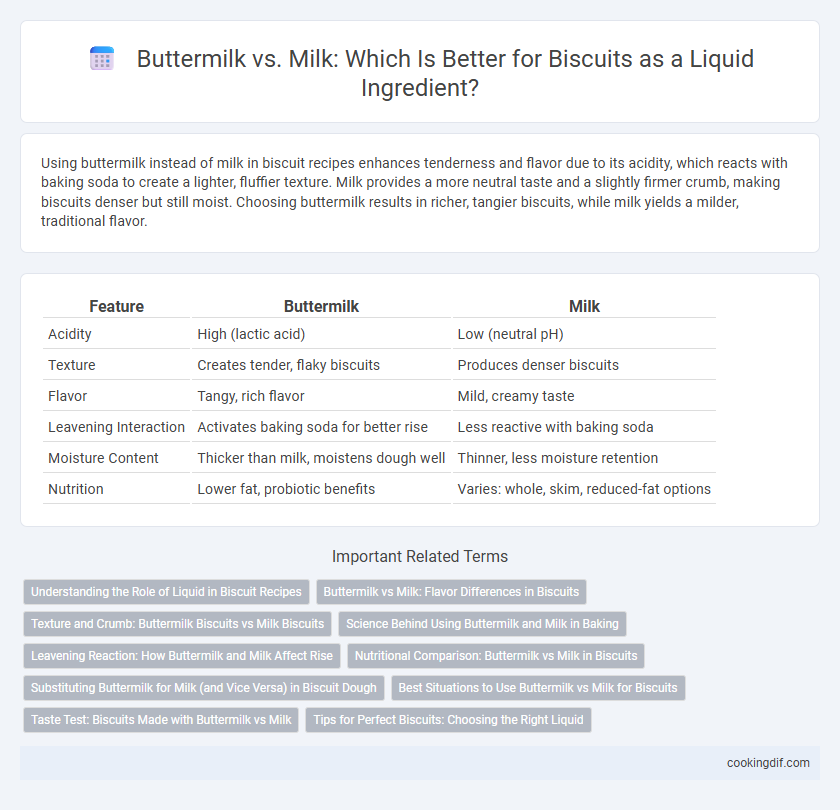Using buttermilk instead of milk in biscuit recipes enhances tenderness and flavor due to its acidity, which reacts with baking soda to create a lighter, fluffier texture. Milk provides a more neutral taste and a slightly firmer crumb, making biscuits denser but still moist. Choosing buttermilk results in richer, tangier biscuits, while milk yields a milder, traditional flavor.
Table of Comparison
| Feature | Buttermilk | Milk |
|---|---|---|
| Acidity | High (lactic acid) | Low (neutral pH) |
| Texture | Creates tender, flaky biscuits | Produces denser biscuits |
| Flavor | Tangy, rich flavor | Mild, creamy taste |
| Leavening Interaction | Activates baking soda for better rise | Less reactive with baking soda |
| Moisture Content | Thicker than milk, moistens dough well | Thinner, less moisture retention |
| Nutrition | Lower fat, probiotic benefits | Varies: whole, skim, reduced-fat options |
Understanding the Role of Liquid in Biscuit Recipes
Buttermilk enhances biscuit texture by reacting with baking soda to create a tender crumb and slight tang, while milk generally produces a milder flavor and softer rise due to its neutral pH. The acidity in buttermilk activates leavening agents more effectively, resulting in fluffier, more flavorful biscuits. Choosing between buttermilk and milk depends on the desired biscuit softness, rise, and taste profile in the recipe.
Buttermilk vs Milk: Flavor Differences in Biscuits
Buttermilk imparts a tangy, slightly acidic flavor to biscuits, creating a more complex and rich taste compared to the milder, creamier profile of milk. Its acidity reacts with baking soda to produce a tender, fluffy texture with subtle savory notes. Milk yields softer, sweeter biscuits but lacks the depth of flavor and slight tang that buttermilk contributes.
Texture and Crumb: Buttermilk Biscuits vs Milk Biscuits
Buttermilk biscuits feature a tender, flaky texture with a slightly tangy crumb due to the acidic reaction between buttermilk and baking soda, which produces more lift and softness. Milk biscuits tend to have a denser crumb and a milder flavor because milk lacks the acidity that enhances leavening, leading to a firmer, chewier biscuit. The acidity in buttermilk also helps break down gluten, resulting in a lighter, more delicate biscuit texture compared to milk-based doughs.
Science Behind Using Buttermilk and Milk in Baking
Buttermilk contains lactic acid, which reacts with baking soda to produce carbon dioxide gas, resulting in lighter, fluffier biscuits with a tender crumb. Milk, lacking this acidity, does not activate baking soda as effectively, often producing denser biscuits without the same rise or texture. The acidity in buttermilk also helps break down gluten strands, enhancing biscuit softness and flavor development during baking.
Leavening Reaction: How Buttermilk and Milk Affect Rise
Buttermilk contains acidic compounds that react with baking soda to produce carbon dioxide, enhancing the leavening and resulting in a lighter, fluffier biscuit texture. Milk lacks this acidity, so recipes using milk often require baking powder instead to achieve a similar rise. The choice between buttermilk and milk significantly impacts the chemical leavening process, which directly affects the biscuit's rise and crumb structure.
Nutritional Comparison: Buttermilk vs Milk in Biscuits
Buttermilk in biscuits offers higher protein content and lower fat compared to whole milk, enhancing texture and nutrient density. The acidity of buttermilk contributes to improved leavening by reacting with baking soda, promoting fluffier biscuits with added calcium and probiotics. Milk provides more carbohydrates and calories but less acidity, which affects biscuit rise and tenderness differently than buttermilk.
Substituting Buttermilk for Milk (and Vice Versa) in Biscuit Dough
Substituting buttermilk for milk in biscuit dough enhances tenderness and tang due to buttermilk's acidity, which reacts with baking soda to create a lighter texture. When using milk instead of buttermilk, adding a small amount of vinegar or lemon juice can mimic this acidity and help achieve similar rise and crumb structure. Accurate substitution requires adjusting leavening agents to balance pH and moisture levels for optimal biscuit consistency.
Best Situations to Use Buttermilk vs Milk for Biscuits
Buttermilk is ideal for biscuits that require a tender, flaky texture with a slight tang, as its acidity reacts with baking soda to create a light rise. Milk works best in recipes needing a milder flavor and a slightly denser crumb, ideal for buttery, rich biscuits. Choose buttermilk for Southern-style or fluffy biscuits, and milk for standard biscuits where subtle sweetness and softness are preferred.
Taste Test: Biscuits Made with Buttermilk vs Milk
Biscuits made with buttermilk have a tangy, richer flavor and a tender crumb compared to those made with regular milk, which tend to be milder and softer but less complex in taste. The natural acidity in buttermilk reacts with baking soda, creating a fluffier texture and enhanced rise in the biscuits. Milk-based biscuits offer a neutral flavor profile and a slightly denser texture, appealing to those who prefer a more classic biscuit taste without the tang.
Tips for Perfect Biscuits: Choosing the Right Liquid
Using buttermilk instead of milk enhances biscuit texture by creating a tender crumb and slight tanginess due to its acidity, which reacts with baking soda to produce a light, fluffy rise. Opt for cold buttermilk to maintain dough temperature, preventing gluten overdevelopment and ensuring flakiness. When only milk is available, adding a teaspoon of lemon juice or vinegar per cup can mimic buttermilk's acidity to achieve similar biscuit softness and rise.
Buttermilk vs Milk for liquid ingredient Infographic

 cookingdif.com
cookingdif.com